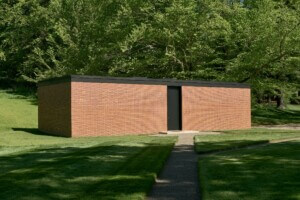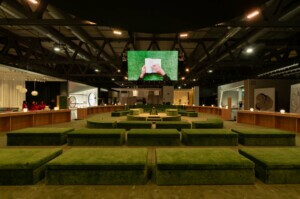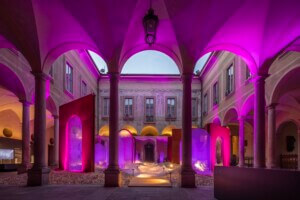The Beauty of Impermanence
Sharjah Architecture Triennial
Sharjah, UAE
Through March 10, 2024
It only takes about an hour to lose yourself in the desert. Tracking my van’s route via Google Maps’s blue dot, I witnessed the scale of the UAE come into focus. Our vehicle is smack in the middle of the country, a triangular wedge protruding into the Persian Gulf. We’re driving about an hour southwest from the coastal emirate of Sharjah to Al-Madam, a desert community home to many of the region’s Bedouin tribes.
Al-Madam is home to the Ghost Village, a small collection of concrete homes clustered around a path and central square. But it’s all buried in reddish sand, eerie and abandoned. Mounds of the desert pile up to the rafters, leaving only the occasional doorway or window frame open as winds shift the stuff throughout town.

The Ghost Village is a living reminder of the failures of modernism. The village was planned and constructed in the mid-1970s as a permanent residence for the Al Ketbi tribe. But by the early 1990s, the entire town was abandoned. Though the concrete homes represented a “modern” lifestyle, the tribe attempted to explain that the desert was moving around them. It was a constant battle against the ever-accumulating sands. Eventually they chose to stop fighting the landscape.
All aspects of Al-Madam’s story—its legacy and critique, plus its location and community—make it emblematic of the themes for the second iteration of the Sharjah Architecture Triennial (SAT). The Ghost Village hosts DAAR’s moving installation, Concrete Tent, but acts as a much larger metaphor for curator and Nigerian architect Tosin Oshinowo’s theme: The Beauty of Impermanence.
Are all architects trying to create “constructive and suggestive utopias?” This musing by Oshinowo opened SAT on November 10. Spread across the “dry” (no alcohol) and relatively conservative emirate in the process of solidifying its reputation as the artistic and cultural center of the UAE, four main sites of activation posit new futures for the Sharjah locally, and the Global South generally, through the display of architectural imagination.
This year, participants coalesced around themes of reuse and adaptation in myriad ways grounded in the soon-to-be global condition of precarity and scarcity. As Oshinowo wrote in her curatorial statement, “Scarcity has engendered a culture of re-use, re-appropriation, innovation, and collaboration.” She is discussing the Global South, and in particular her country of Nigeria, but in many ways SAT is a looking glass through which the entire globe will begin to see the effects of extraction, depletion, and climate change. She said that this vision “embraces the idea that nothing can be permanent, and that everything in our environment should adapt to conditions of scarcity in order to match our realities and needs, thereby resulting in a progressive and evolving architecture.”

The opening took place during the war in Gaza, and SAT staff and participants were unified in their support for Palestine and their condemnation of violence. With several participants either being from Palestine or working with marginalized Palestinian communities, the work, of course assembled years prior to October 7, suddenly took on additional urgency. Projects that may have felt conceptual or historical a year ago were now read as solutions and calls to action, not to mention being emotional encounters for viewers and participants alike. But the very base of the triennial project serves as an oasis in turbulent times: Oshinowo asserted in her opening remarks that “this is a space for solidarity and a space for peace.”
Oshinowo grounded us in SAT’s main hall, the newly renovated courtyard of Al Qasimiyah School, which hosts 19 of the triennial’s 30 installations. But the school itself is emblematic of the passive vernacular architecture of the region that adapts to the extreme heat and sun of the desert peninsula. There was almost no artificial lighting, but open clerestories allow air flow and heat release, and perforated walls both let in light and enable for natural ventilation. Oshinowo, with exhibition designers Space Caviar, outfitted this courtyard for socializing around a coffee and juice bar, as well as bringing large groups together for panels, workshops, and lectures.
I was perched on a pile of CMUs padded with a yellow cushion while listening to her opening remarks, which was an excellent vantage point to see the rest of the main hall. It was all furnished with piles of bricks, plywood, and other CMU mounds of varying heights. Two long benches inspired my envy: They had vertical concrete elements, which translated into backrests. Oshinowo gestured around the atrium at her furnishings and offered a bit of insight into their creation. “We had this naïve idea that the industrial areas would ‘lend’ us some material,” she said, laughing. “They were not interested. We bought all the raw material and struck an agreement to eventually sell it back at a loss.” It was a telling remark that even an event set on reuse, adaptation, and generational design knowledge transfer opted for virgin construction material for its construction.
Beyond the atrium, Oshinowo’s curatorial vision set about addressing the many disparities in architecture culture. In both its staff and invited participants, the event struck a gender balance and majority representation of the Global South. In her strong and pleasantly cadenced voice, Oshinowo spoke of locality and what that idea means in a place like the UAE. She introduced the omnipresent theme of consumerism and Western “cornucopianism,” whose hallucinations of resource extendibility are part of the reason our planet is in chaos (It’s 96 degrees here on opening day, a temperature that, according to SAT staff, would have been unthinkable just 15 years ago).

Additional exhibitions brought visitors into the heart of Sharjah, revealing vernacular Emirati culture beyond the walls and galleries of SAT’s central hub. DAAR’s Concrete Tent in Al-Madam may have been the furthest-flung venue, but other offsite installations included We Rest at the Bird’s Nest, a scaffold tower clad in hundreds of nests by Papa Omotayo and Eve Nnaji situated in Sharjah’s inland grid of Industrial Areas. Made with a mixture of paper and grass, there’s a contrast here between the natural and the industrial, but the alleyway installation also brings them together so both birds and workers can find respite. Closer to Sharjah’s historic center on the coast, Super Limbo, a soft textile installation by Limbo Accra, sits within the stalled concrete shell of the Sharjah Mall.

The stark differences between the slim alleyways carved out for shade and respite during a workday in the city’s uniformly gridded and numbered industrial blocs and the sprawling commercial leisure palace of the Mall introduced tension to SAT and the emirate’s duality: Sharjah is home to hundreds of thousands of migrant workers who come on risky, short-term contracts to construct the high-rises that go on to pepper tourist postcards. When projects like the Sharjah Mall stall or go bankrupt, the labor force working the Industrial Areas for the projects dissipates invisibly to the naked eye but comes into focus when juxtaposing these two sites.
SAT had a base camp 2.0 of sorts outside of Al Qasimiyah School: The Old Al Jubail vegetable market has also been reclaimed and renovated by the SAT team to host eight installations and a cinema after being abandoned: City planners favored a new Super Target–sized souk just across the street in efforts to modernize the city. Its creation required “pushing back the sea,” as Victoria Braga of RUÍNA Architecture told us—and relying on artificial lighting and air conditioning. Both were absent in the passively cooled and naturally lit Al Jubail, built in the 1980s. Curved in plan, its form facilitated cross-breezes using traditional materials. Old vegetable stalls still bore their colorful signage for various vendor names, sinks for washing produce, and mirrors for amping up displays, but for the next year they are filled with installations with a more spiritual and tactile character than seen elsewhere.

Here, the “artiness” of architecture was on full display. Feet trod on a bed of cinnamon to aromatize the air of a squat structure titled Àrò-òtó (the shrine of the ground) by Bubu Ogisi. Clad in sisal textiles, it’s envisioned as a home for one’s Djinn or Èhì spirit. Olalekan Jeyifous also curated a gallery of sorts: SHJ-1X72 – 1X89 is a collection of hanging prints depicting Sharjah in an alternate universe. His eco-utopia is premised on an imaginative history where Sharjah’s city planning strategies favored resource sharing, heritage and community versus tourism and foreign investment. The aesthetic, he purports, “embraces whimsy” as its blends old and new.

Perhaps SAT’s most polarizing site is an old slaughterhouse located just outside the market. Taken over by Cave_Bureau, this active complex uncannily transposes visitors into the objects on display. Following the path of an animal taken from pen to slaughter, the “museum” envisioned by Cave_Bureau is filled with cave allegories, spiritually rich sculptural works, historic ephemera, and a sinuous sheep pelt work by artist Adrian Pepe made to both resemble and tactically feel “intestinal.”
Within the slaughterhouse, which still smelled of blood and formaldehyde, Cave_Bureau projects a film asserting that all architecture is a manifestation of our human desires. But the “we” designated to speak for the many to guide “our” interests is a small group. Whose desires? Certainly those who benefit from the new construction which lines the Persian Gulf benefit from the Western idea of progress, as seen in the soaring height and bulk of this city of the future. But what about the goals of the many who live and work in the shadow of these structures?


Sharjah seems an odd place to speak of reuse and climactic adaptability. Oshinowo’s focus on reuse and climactic adaptability in a place like this challenges the dominant modes of architectural production. Perhaps a triennial can establish a framework from which to envision “responsible balance,” as Oshinowo said—the microscale of SAT feels like a suggestive utopia amid a global value system gone wrong. But instead of shouting into the void, Oshinowo and SAT’s participants are committed to acts of making and placing bodies in useful, if even uncomfortable scenarios.
This action also reflects some of Sharjah’s informal urbanity. On my visit, I regularly saw groups of friends or entire families picnicking in the sporadic stretches of grass planted on highway medians. I watched them from a vehicle stalled in bumper-to-bumper traffic, transporting me in air conditioned–comfort over a stretch of land a New Yorker could traverse on foot in 20 minutes.
How can one triennial update our value systems? Or even attempt to explicate what’s wrong with them? While SAT places visitors face-to-face with almost 700,000 square feet of decaying concrete or leads them through a slaughterhouse—hooks, knives, and all—it can also do softer things like activate sites of memory. Back in Al Madam, beneath the pitched roof of the Concrete Tent, I listened to DAAR’s Sandi Hilal read the names and ages of people killed in Palestine. Her voice breaks on occasion and ebbs and flows in volume as her tone shifts from despair to anger to listlessness. Our group is meditating on what it means to be in a state of permanent temporariness. (We’ve also been given “permission to mourn,” and invited to take our shoes off to sit on the soft carpets beneath the tent.) While permanent temporariness is a condition of dislocation caused by political, economic, and environmental changes, its consequences aren’t merely physical, like a lack of housing. It deprives people, as Hilal said, “of the possibility to act and engage with the present.”
I remain cautiously optimistic that attendees will go beyond the resort and into the cool, quiet of DAAR’s Concrete Tent or browse the titles lining SAT’s reading room. Oshinowo reminds us that “everything is subject to evolution and repair,” and this iteration of the triennial encourages learning instead of isolation in a world that feels hopelessly backward.










